A Comprehensive Analysis of Employee Motivation and Work Factors
VerifiedAdded on 2023/06/05
|7
|1956
|122
Essay
AI Summary
This essay delves into the multifaceted realm of employee motivation, examining the factors that drive individuals to work. It explores both the positive and negative influences experienced within job roles, such as recognition, healthcare benefits, competition, fair salary, and involvement in decision-making. The essay also addresses negative factors like lack of security, limited educational facilities, and lack of promotion opportunities. The essay concludes by emphasizing the importance of understanding these factors to foster a productive and satisfying work environment. The provided references offer a comprehensive overview of the relevant literature on the subject matter.
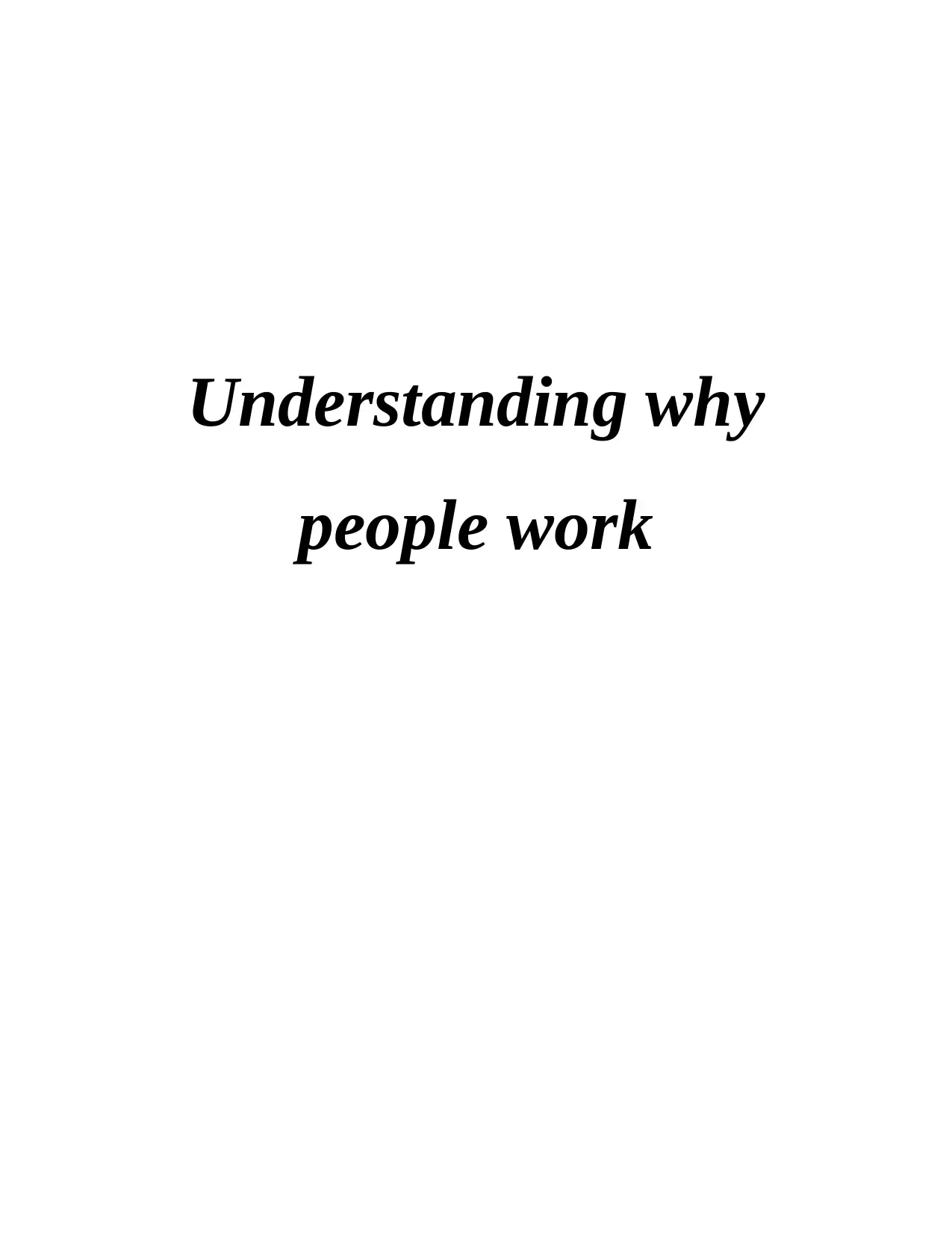
Understanding why
people work
people work
Paraphrase This Document
Need a fresh take? Get an instant paraphrase of this document with our AI Paraphraser
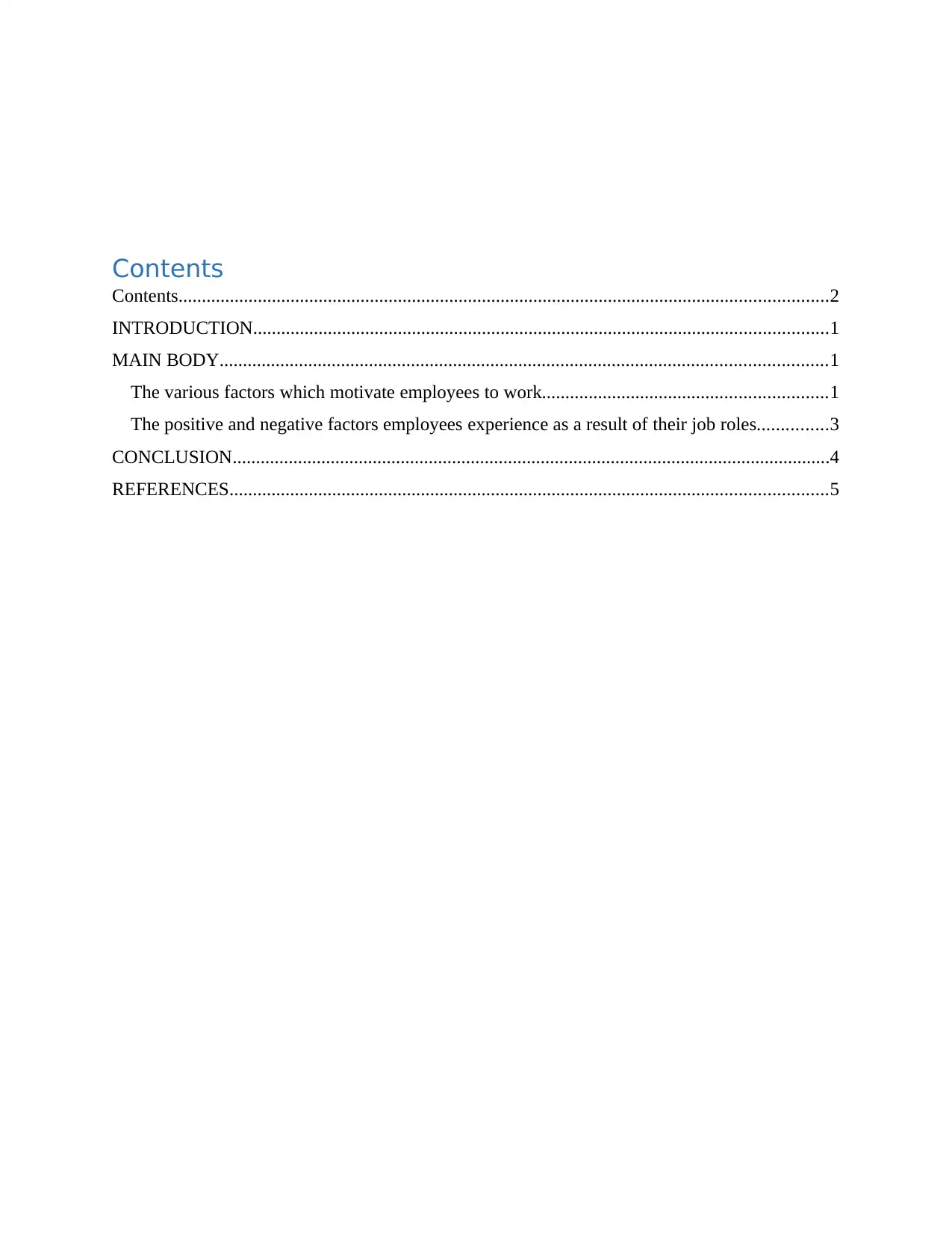
Contents
Contents...........................................................................................................................................2
INTRODUCTION...........................................................................................................................1
MAIN BODY..................................................................................................................................1
The various factors which motivate employees to work.............................................................1
The positive and negative factors employees experience as a result of their job roles...............3
CONCLUSION................................................................................................................................4
REFERENCES................................................................................................................................5
Contents...........................................................................................................................................2
INTRODUCTION...........................................................................................................................1
MAIN BODY..................................................................................................................................1
The various factors which motivate employees to work.............................................................1
The positive and negative factors employees experience as a result of their job roles...............3
CONCLUSION................................................................................................................................4
REFERENCES................................................................................................................................5
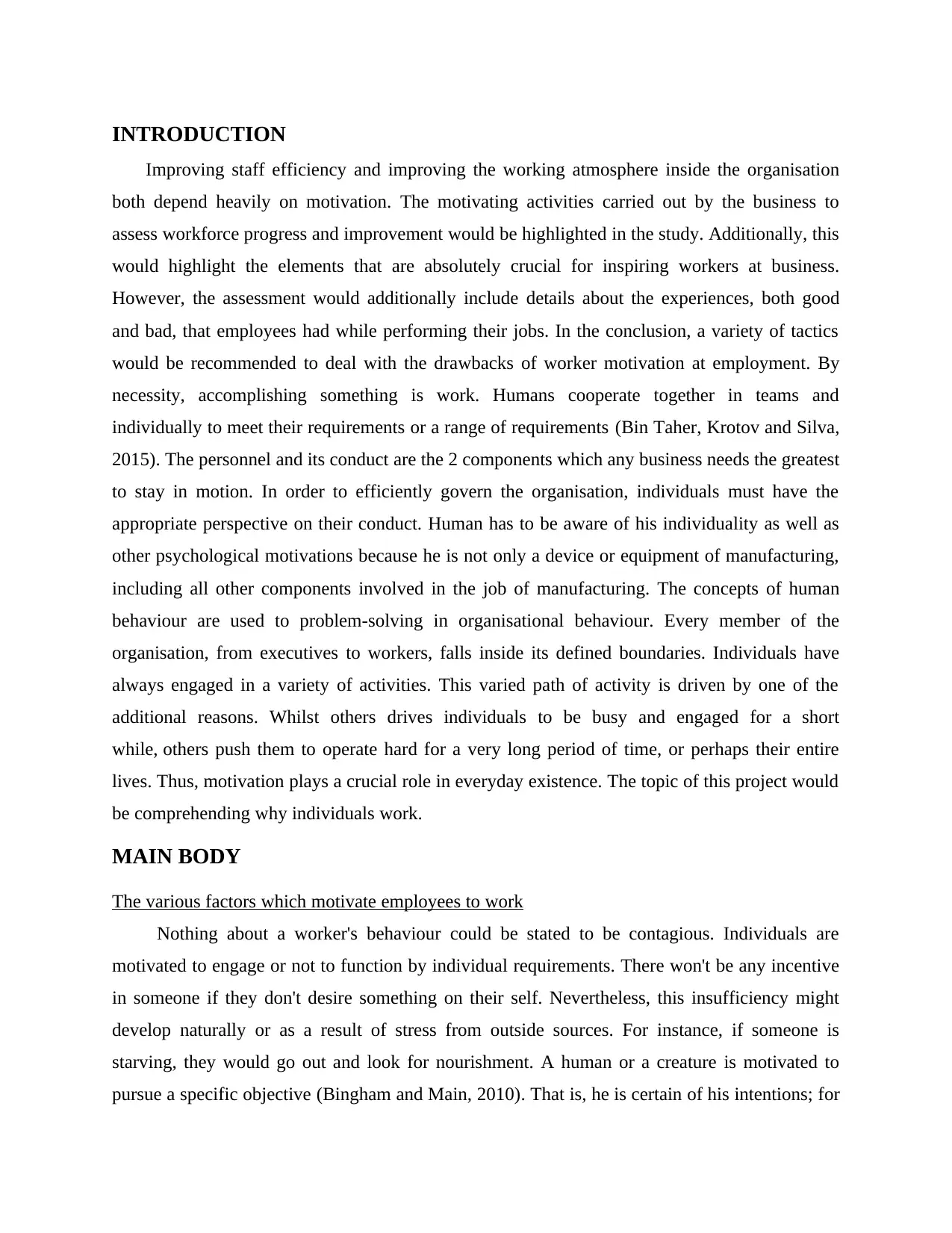
INTRODUCTION
Improving staff efficiency and improving the working atmosphere inside the organisation
both depend heavily on motivation. The motivating activities carried out by the business to
assess workforce progress and improvement would be highlighted in the study. Additionally, this
would highlight the elements that are absolutely crucial for inspiring workers at business.
However, the assessment would additionally include details about the experiences, both good
and bad, that employees had while performing their jobs. In the conclusion, a variety of tactics
would be recommended to deal with the drawbacks of worker motivation at employment. By
necessity, accomplishing something is work. Humans cooperate together in teams and
individually to meet their requirements or a range of requirements (Bin Taher, Krotov and Silva,
2015). The personnel and its conduct are the 2 components which any business needs the greatest
to stay in motion. In order to efficiently govern the organisation, individuals must have the
appropriate perspective on their conduct. Human has to be aware of his individuality as well as
other psychological motivations because he is not only a device or equipment of manufacturing,
including all other components involved in the job of manufacturing. The concepts of human
behaviour are used to problem-solving in organisational behaviour. Every member of the
organisation, from executives to workers, falls inside its defined boundaries. Individuals have
always engaged in a variety of activities. This varied path of activity is driven by one of the
additional reasons. Whilst others drives individuals to be busy and engaged for a short
while, others push them to operate hard for a very long period of time, or perhaps their entire
lives. Thus, motivation plays a crucial role in everyday existence. The topic of this project would
be comprehending why individuals work.
MAIN BODY
The various factors which motivate employees to work
Nothing about a worker's behaviour could be stated to be contagious. Individuals are
motivated to engage or not to function by individual requirements. There won't be any incentive
in someone if they don't desire something on their self. Nevertheless, this insufficiency might
develop naturally or as a result of stress from outside sources. For instance, if someone is
starving, they would go out and look for nourishment. A human or a creature is motivated to
pursue a specific objective (Bingham and Main, 2010). That is, he is certain of his intentions; for
Improving staff efficiency and improving the working atmosphere inside the organisation
both depend heavily on motivation. The motivating activities carried out by the business to
assess workforce progress and improvement would be highlighted in the study. Additionally, this
would highlight the elements that are absolutely crucial for inspiring workers at business.
However, the assessment would additionally include details about the experiences, both good
and bad, that employees had while performing their jobs. In the conclusion, a variety of tactics
would be recommended to deal with the drawbacks of worker motivation at employment. By
necessity, accomplishing something is work. Humans cooperate together in teams and
individually to meet their requirements or a range of requirements (Bin Taher, Krotov and Silva,
2015). The personnel and its conduct are the 2 components which any business needs the greatest
to stay in motion. In order to efficiently govern the organisation, individuals must have the
appropriate perspective on their conduct. Human has to be aware of his individuality as well as
other psychological motivations because he is not only a device or equipment of manufacturing,
including all other components involved in the job of manufacturing. The concepts of human
behaviour are used to problem-solving in organisational behaviour. Every member of the
organisation, from executives to workers, falls inside its defined boundaries. Individuals have
always engaged in a variety of activities. This varied path of activity is driven by one of the
additional reasons. Whilst others drives individuals to be busy and engaged for a short
while, others push them to operate hard for a very long period of time, or perhaps their entire
lives. Thus, motivation plays a crucial role in everyday existence. The topic of this project would
be comprehending why individuals work.
MAIN BODY
The various factors which motivate employees to work
Nothing about a worker's behaviour could be stated to be contagious. Individuals are
motivated to engage or not to function by individual requirements. There won't be any incentive
in someone if they don't desire something on their self. Nevertheless, this insufficiency might
develop naturally or as a result of stress from outside sources. For instance, if someone is
starving, they would go out and look for nourishment. A human or a creature is motivated to
pursue a specific objective (Bingham and Main, 2010). That is, he is certain of his intentions; for
⊘ This is a preview!⊘
Do you want full access?
Subscribe today to unlock all pages.

Trusted by 1+ million students worldwide
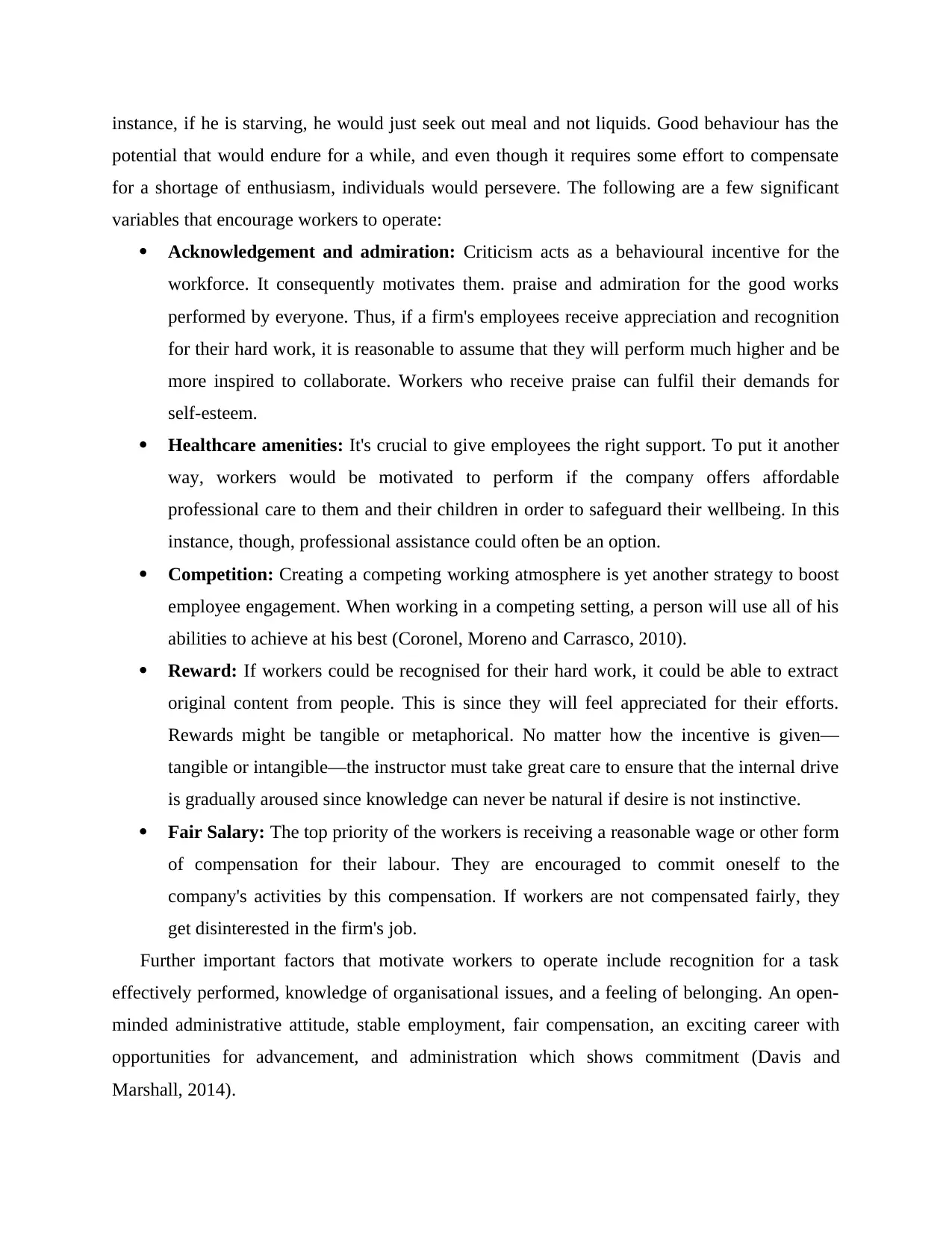
instance, if he is starving, he would just seek out meal and not liquids. Good behaviour has the
potential that would endure for a while, and even though it requires some effort to compensate
for a shortage of enthusiasm, individuals would persevere. The following are a few significant
variables that encourage workers to operate:
Acknowledgement and admiration: Criticism acts as a behavioural incentive for the
workforce. It consequently motivates them. praise and admiration for the good works
performed by everyone. Thus, if a firm's employees receive appreciation and recognition
for their hard work, it is reasonable to assume that they will perform much higher and be
more inspired to collaborate. Workers who receive praise can fulfil their demands for
self-esteem.
Healthcare amenities: It's crucial to give employees the right support. To put it another
way, workers would be motivated to perform if the company offers affordable
professional care to them and their children in order to safeguard their wellbeing. In this
instance, though, professional assistance could often be an option.
Competition: Creating a competing working atmosphere is yet another strategy to boost
employee engagement. When working in a competing setting, a person will use all of his
abilities to achieve at his best (Coronel, Moreno and Carrasco, 2010).
Reward: If workers could be recognised for their hard work, it could be able to extract
original content from people. This is since they will feel appreciated for their efforts.
Rewards might be tangible or metaphorical. No matter how the incentive is given—
tangible or intangible—the instructor must take great care to ensure that the internal drive
is gradually aroused since knowledge can never be natural if desire is not instinctive.
Fair Salary: The top priority of the workers is receiving a reasonable wage or other form
of compensation for their labour. They are encouraged to commit oneself to the
company's activities by this compensation. If workers are not compensated fairly, they
get disinterested in the firm's job.
Further important factors that motivate workers to operate include recognition for a task
effectively performed, knowledge of organisational issues, and a feeling of belonging. An open-
minded administrative attitude, stable employment, fair compensation, an exciting career with
opportunities for advancement, and administration which shows commitment (Davis and
Marshall, 2014).
potential that would endure for a while, and even though it requires some effort to compensate
for a shortage of enthusiasm, individuals would persevere. The following are a few significant
variables that encourage workers to operate:
Acknowledgement and admiration: Criticism acts as a behavioural incentive for the
workforce. It consequently motivates them. praise and admiration for the good works
performed by everyone. Thus, if a firm's employees receive appreciation and recognition
for their hard work, it is reasonable to assume that they will perform much higher and be
more inspired to collaborate. Workers who receive praise can fulfil their demands for
self-esteem.
Healthcare amenities: It's crucial to give employees the right support. To put it another
way, workers would be motivated to perform if the company offers affordable
professional care to them and their children in order to safeguard their wellbeing. In this
instance, though, professional assistance could often be an option.
Competition: Creating a competing working atmosphere is yet another strategy to boost
employee engagement. When working in a competing setting, a person will use all of his
abilities to achieve at his best (Coronel, Moreno and Carrasco, 2010).
Reward: If workers could be recognised for their hard work, it could be able to extract
original content from people. This is since they will feel appreciated for their efforts.
Rewards might be tangible or metaphorical. No matter how the incentive is given—
tangible or intangible—the instructor must take great care to ensure that the internal drive
is gradually aroused since knowledge can never be natural if desire is not instinctive.
Fair Salary: The top priority of the workers is receiving a reasonable wage or other form
of compensation for their labour. They are encouraged to commit oneself to the
company's activities by this compensation. If workers are not compensated fairly, they
get disinterested in the firm's job.
Further important factors that motivate workers to operate include recognition for a task
effectively performed, knowledge of organisational issues, and a feeling of belonging. An open-
minded administrative attitude, stable employment, fair compensation, an exciting career with
opportunities for advancement, and administration which shows commitment (Davis and
Marshall, 2014).
Paraphrase This Document
Need a fresh take? Get an instant paraphrase of this document with our AI Paraphraser
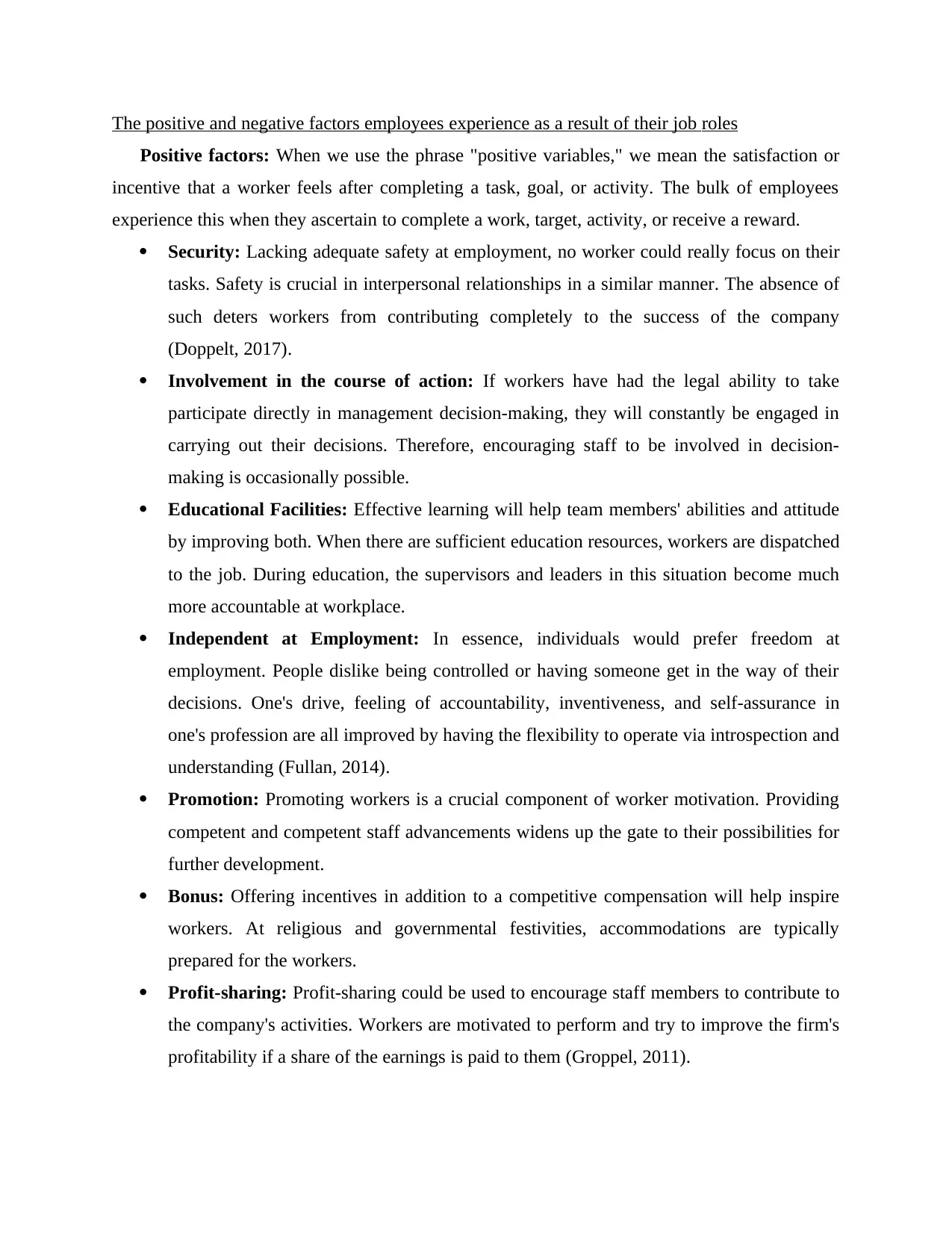
The positive and negative factors employees experience as a result of their job roles
Positive factors: When we use the phrase "positive variables," we mean the satisfaction or
incentive that a worker feels after completing a task, goal, or activity. The bulk of employees
experience this when they ascertain to complete a work, target, activity, or receive a reward.
Security: Lacking adequate safety at employment, no worker could really focus on their
tasks. Safety is crucial in interpersonal relationships in a similar manner. The absence of
such deters workers from contributing completely to the success of the company
(Doppelt, 2017).
Involvement in the course of action: If workers have had the legal ability to take
participate directly in management decision-making, they will constantly be engaged in
carrying out their decisions. Therefore, encouraging staff to be involved in decision-
making is occasionally possible.
Educational Facilities: Effective learning will help team members' abilities and attitude
by improving both. When there are sufficient education resources, workers are dispatched
to the job. During education, the supervisors and leaders in this situation become much
more accountable at workplace.
Independent at Employment: In essence, individuals would prefer freedom at
employment. People dislike being controlled or having someone get in the way of their
decisions. One's drive, feeling of accountability, inventiveness, and self-assurance in
one's profession are all improved by having the flexibility to operate via introspection and
understanding (Fullan, 2014).
Promotion: Promoting workers is a crucial component of worker motivation. Providing
competent and competent staff advancements widens up the gate to their possibilities for
further development.
Bonus: Offering incentives in addition to a competitive compensation will help inspire
workers. At religious and governmental festivities, accommodations are typically
prepared for the workers.
Profit-sharing: Profit-sharing could be used to encourage staff members to contribute to
the company's activities. Workers are motivated to perform and try to improve the firm's
profitability if a share of the earnings is paid to them (Groppel, 2011).
Positive factors: When we use the phrase "positive variables," we mean the satisfaction or
incentive that a worker feels after completing a task, goal, or activity. The bulk of employees
experience this when they ascertain to complete a work, target, activity, or receive a reward.
Security: Lacking adequate safety at employment, no worker could really focus on their
tasks. Safety is crucial in interpersonal relationships in a similar manner. The absence of
such deters workers from contributing completely to the success of the company
(Doppelt, 2017).
Involvement in the course of action: If workers have had the legal ability to take
participate directly in management decision-making, they will constantly be engaged in
carrying out their decisions. Therefore, encouraging staff to be involved in decision-
making is occasionally possible.
Educational Facilities: Effective learning will help team members' abilities and attitude
by improving both. When there are sufficient education resources, workers are dispatched
to the job. During education, the supervisors and leaders in this situation become much
more accountable at workplace.
Independent at Employment: In essence, individuals would prefer freedom at
employment. People dislike being controlled or having someone get in the way of their
decisions. One's drive, feeling of accountability, inventiveness, and self-assurance in
one's profession are all improved by having the flexibility to operate via introspection and
understanding (Fullan, 2014).
Promotion: Promoting workers is a crucial component of worker motivation. Providing
competent and competent staff advancements widens up the gate to their possibilities for
further development.
Bonus: Offering incentives in addition to a competitive compensation will help inspire
workers. At religious and governmental festivities, accommodations are typically
prepared for the workers.
Profit-sharing: Profit-sharing could be used to encourage staff members to contribute to
the company's activities. Workers are motivated to perform and try to improve the firm's
profitability if a share of the earnings is paid to them (Groppel, 2011).
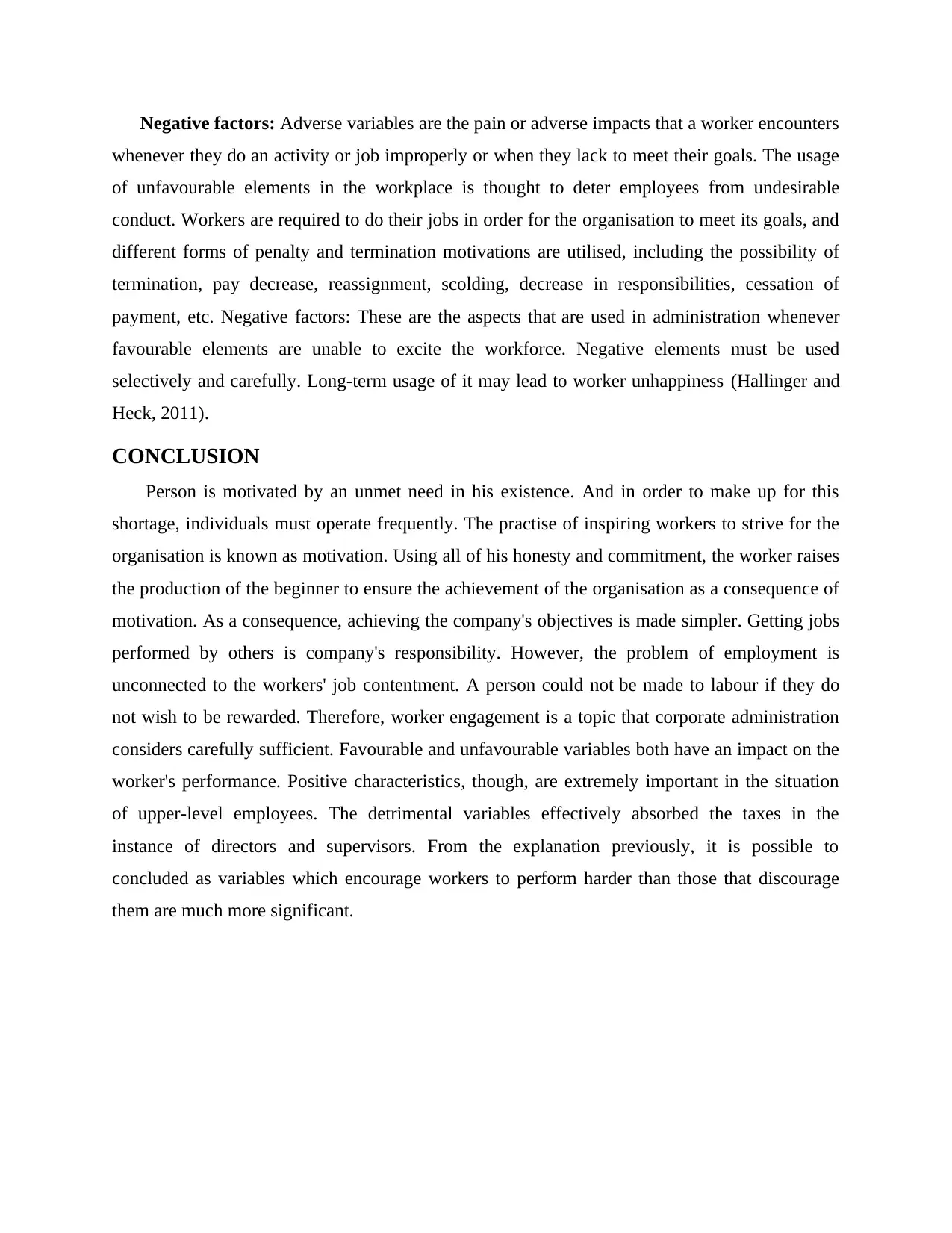
Negative factors: Adverse variables are the pain or adverse impacts that a worker encounters
whenever they do an activity or job improperly or when they lack to meet their goals. The usage
of unfavourable elements in the workplace is thought to deter employees from undesirable
conduct. Workers are required to do their jobs in order for the organisation to meet its goals, and
different forms of penalty and termination motivations are utilised, including the possibility of
termination, pay decrease, reassignment, scolding, decrease in responsibilities, cessation of
payment, etc. Negative factors: These are the aspects that are used in administration whenever
favourable elements are unable to excite the workforce. Negative elements must be used
selectively and carefully. Long-term usage of it may lead to worker unhappiness (Hallinger and
Heck, 2011).
CONCLUSION
Person is motivated by an unmet need in his existence. And in order to make up for this
shortage, individuals must operate frequently. The practise of inspiring workers to strive for the
organisation is known as motivation. Using all of his honesty and commitment, the worker raises
the production of the beginner to ensure the achievement of the organisation as a consequence of
motivation. As a consequence, achieving the company's objectives is made simpler. Getting jobs
performed by others is company's responsibility. However, the problem of employment is
unconnected to the workers' job contentment. A person could not be made to labour if they do
not wish to be rewarded. Therefore, worker engagement is a topic that corporate administration
considers carefully sufficient. Favourable and unfavourable variables both have an impact on the
worker's performance. Positive characteristics, though, are extremely important in the situation
of upper-level employees. The detrimental variables effectively absorbed the taxes in the
instance of directors and supervisors. From the explanation previously, it is possible to
concluded as variables which encourage workers to perform harder than those that discourage
them are much more significant.
whenever they do an activity or job improperly or when they lack to meet their goals. The usage
of unfavourable elements in the workplace is thought to deter employees from undesirable
conduct. Workers are required to do their jobs in order for the organisation to meet its goals, and
different forms of penalty and termination motivations are utilised, including the possibility of
termination, pay decrease, reassignment, scolding, decrease in responsibilities, cessation of
payment, etc. Negative factors: These are the aspects that are used in administration whenever
favourable elements are unable to excite the workforce. Negative elements must be used
selectively and carefully. Long-term usage of it may lead to worker unhappiness (Hallinger and
Heck, 2011).
CONCLUSION
Person is motivated by an unmet need in his existence. And in order to make up for this
shortage, individuals must operate frequently. The practise of inspiring workers to strive for the
organisation is known as motivation. Using all of his honesty and commitment, the worker raises
the production of the beginner to ensure the achievement of the organisation as a consequence of
motivation. As a consequence, achieving the company's objectives is made simpler. Getting jobs
performed by others is company's responsibility. However, the problem of employment is
unconnected to the workers' job contentment. A person could not be made to labour if they do
not wish to be rewarded. Therefore, worker engagement is a topic that corporate administration
considers carefully sufficient. Favourable and unfavourable variables both have an impact on the
worker's performance. Positive characteristics, though, are extremely important in the situation
of upper-level employees. The detrimental variables effectively absorbed the taxes in the
instance of directors and supervisors. From the explanation previously, it is possible to
concluded as variables which encourage workers to perform harder than those that discourage
them are much more significant.
⊘ This is a preview!⊘
Do you want full access?
Subscribe today to unlock all pages.

Trusted by 1+ million students worldwide
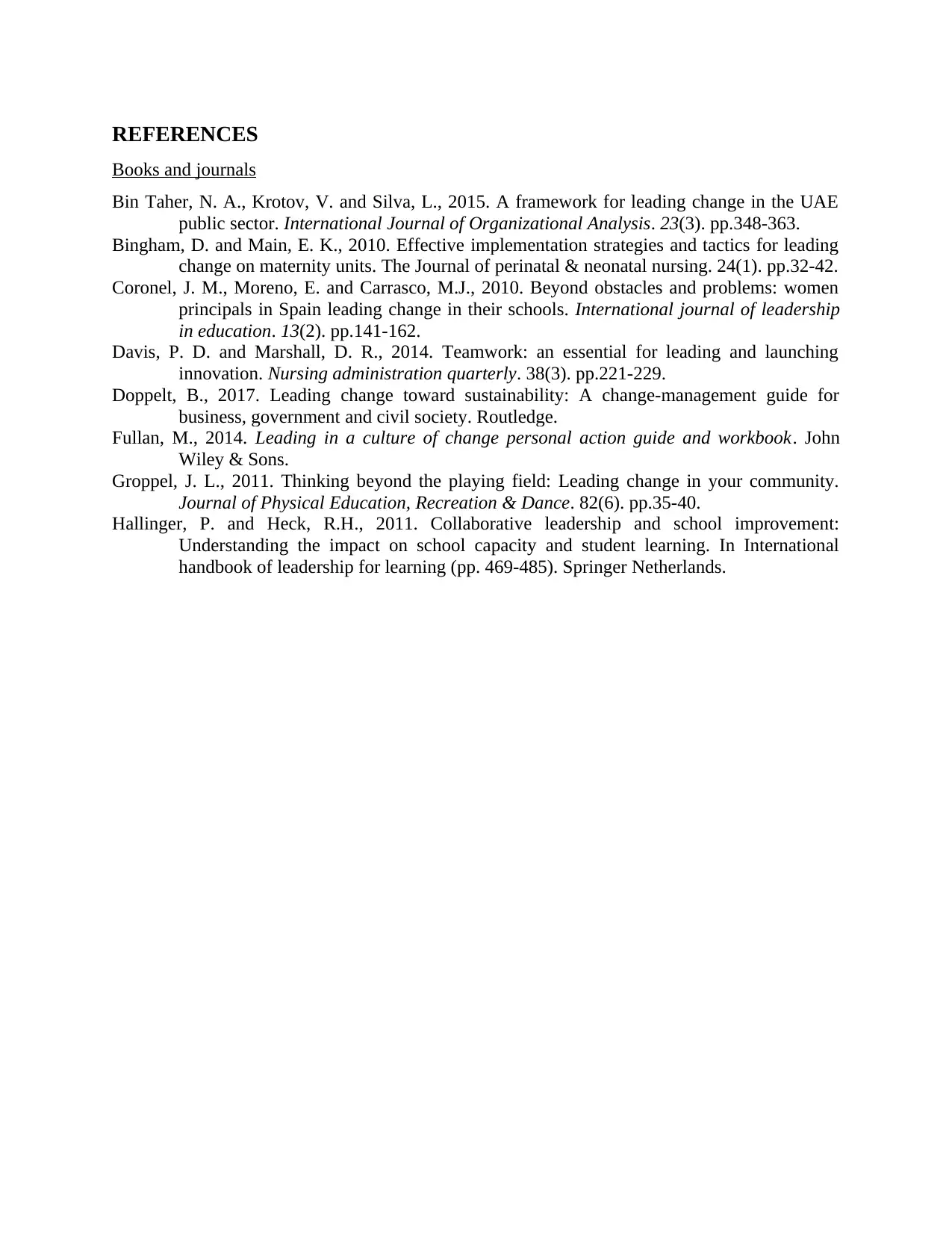
REFERENCES
Books and journals
Bin Taher, N. A., Krotov, V. and Silva, L., 2015. A framework for leading change in the UAE
public sector. International Journal of Organizational Analysis. 23(3). pp.348-363.
Bingham, D. and Main, E. K., 2010. Effective implementation strategies and tactics for leading
change on maternity units. The Journal of perinatal & neonatal nursing. 24(1). pp.32-42.
Coronel, J. M., Moreno, E. and Carrasco, M.J., 2010. Beyond obstacles and problems: women
principals in Spain leading change in their schools. International journal of leadership
in education. 13(2). pp.141-162.
Davis, P. D. and Marshall, D. R., 2014. Teamwork: an essential for leading and launching
innovation. Nursing administration quarterly. 38(3). pp.221-229.
Doppelt, B., 2017. Leading change toward sustainability: A change-management guide for
business, government and civil society. Routledge.
Fullan, M., 2014. Leading in a culture of change personal action guide and workbook. John
Wiley & Sons.
Groppel, J. L., 2011. Thinking beyond the playing field: Leading change in your community.
Journal of Physical Education, Recreation & Dance. 82(6). pp.35-40.
Hallinger, P. and Heck, R.H., 2011. Collaborative leadership and school improvement:
Understanding the impact on school capacity and student learning. In International
handbook of leadership for learning (pp. 469-485). Springer Netherlands.
Books and journals
Bin Taher, N. A., Krotov, V. and Silva, L., 2015. A framework for leading change in the UAE
public sector. International Journal of Organizational Analysis. 23(3). pp.348-363.
Bingham, D. and Main, E. K., 2010. Effective implementation strategies and tactics for leading
change on maternity units. The Journal of perinatal & neonatal nursing. 24(1). pp.32-42.
Coronel, J. M., Moreno, E. and Carrasco, M.J., 2010. Beyond obstacles and problems: women
principals in Spain leading change in their schools. International journal of leadership
in education. 13(2). pp.141-162.
Davis, P. D. and Marshall, D. R., 2014. Teamwork: an essential for leading and launching
innovation. Nursing administration quarterly. 38(3). pp.221-229.
Doppelt, B., 2017. Leading change toward sustainability: A change-management guide for
business, government and civil society. Routledge.
Fullan, M., 2014. Leading in a culture of change personal action guide and workbook. John
Wiley & Sons.
Groppel, J. L., 2011. Thinking beyond the playing field: Leading change in your community.
Journal of Physical Education, Recreation & Dance. 82(6). pp.35-40.
Hallinger, P. and Heck, R.H., 2011. Collaborative leadership and school improvement:
Understanding the impact on school capacity and student learning. In International
handbook of leadership for learning (pp. 469-485). Springer Netherlands.
1 out of 7
Related Documents
Your All-in-One AI-Powered Toolkit for Academic Success.
+13062052269
info@desklib.com
Available 24*7 on WhatsApp / Email
![[object Object]](/_next/static/media/star-bottom.7253800d.svg)
Unlock your academic potential
Copyright © 2020–2025 A2Z Services. All Rights Reserved. Developed and managed by ZUCOL.




